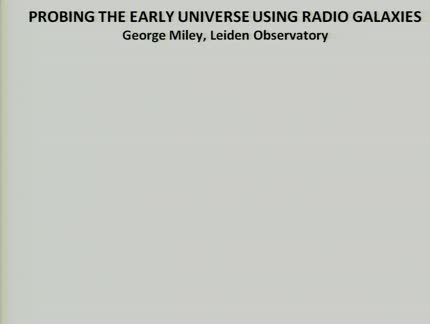Found 4 talks width keyword radio galaxies

Abstract
In the 50 years since their discovery, it has become increasingly recognised that quasars are not merely signposts to the distant Universe, but also play a key role in the overall galaxy evolution process. However, if we are to incorporate quasars into models of galaxy evolution, it's important to understand how, when and where they are triggered. In this talk I will review the latest observational results on the triggering of quasars, based on the morphologies of their host galaxies and star formation properties; I will also discuss the future prospects for understanding quasar triggering using Herschel and ALMA data.

Abstract
The detection and number estimates of supermassive binary black holes (SMBBHs) provide important constraints on the hierarchical models for galaxy formation and evolution. I will present two different approaches for the possible identification of SMBBHs. 1.Radio-optical studies of X-shaped radio sources:X-shaped radio galaxies are extragalactic radio sources that present two pairs of radio lobes passing symmetrically through the center of the host galaxy, giving the galaxy the X-shaped morphology seen on radio maps.This morphology can reflect either a recent merger of two supermassive black holes or the presence of a second active black hole in the galactic nucleus. This scenario is studied by determining the mass, luminosity, jet dynamic age and starburst of a sample of X-shaped sources and comparing the results to a sample of radio-loud active nuclei with similar redshift and luminosities. 2.Compact radio emission in ULX objects: Ultraluminous X-ray sources (ULXs) have luminosities exceeding 10E39 erg/s, suggesting either the presence of black holes larger than stellar mass black holes or sources apparently radiating above the Eddington limit. I will present milliarcsecond-scale radio observations of some ULXs located within optical bright galaxies, resolving their compact radio emission, and measuring its brightness temperature and spectral properties. This allows us to uncover the nature of these sources and investigate whether they are intermediate mass black holes or supermassive black holes stripped of their accretion disks in post-merger systems.

Abstract
Despite speculation that both starburst and nuclear activity in galaxies may be intimately linked via the common triggering mechanism of mergers and interactions, very little is known about the true nature of the link. Thus, the role of AGN in the formation and evolution of galaxies is still not well established. I will present deep Gemini/GMOS imaging observations which are used to investigate the triggering mechanism(s) in a complete sample of radio-loud AGN for which, uniquely, we have quantified the level of both the AGN and star formation activity. I will show results on the proportion of powerful radio galaxies triggered in galaxy mergers and also on the link between the degree of star formation/AGN activity and the interaction status of the host galaxies.
Abstract
Luminous high-redshift radio galaxies (HzRGs) are associated with the most massive known galaxies in the early Universe. These galaxies have the properties expected of the progenitors of dominant galaxies in rich clusters.
I shall describe the properties of HzRGs and demonstrate how they can be used to study the formation and evolution of galaxies and clusters. I shall also show how LOFAR, the new European radio telescope, can be used to extend these probes into the epoch of reionisation.
« Newer Older »
Upcoming talks
- Runaway O and Be stars found using Gaia DR3, new stellar bow shocks and search for binariesMar Carretero CastrilloTuesday April 30, 2024 - 12:30 GMT+1 (Aula)









